Exhalation valves
a technology of exhalation valve and valve body, which is applied in the direction of inhalators, breathing masks, breathing protection, etc., can solve the problems of high energy consumption, high cost, and difficulty in achieving the effect of reducing the risk of lung deformation
- Summary
- Abstract
- Description
- Claims
- Application Information
AI Technical Summary
Benefits of technology
Problems solved by technology
Method used
Image
Examples
Embodiment Construction
[0040]FIGS. 1, 2 and 3 show an exhalation valve according to the invention which is generally designated 10. The exhalation valve 10 comprises a respiratory passageway 12, an exhalation port 14, a lower housing 16, an upper housing 18, a gas chamber 20, a gas inlet pipe 22 and a membrane of flexible material 24 (the membrane 24 is not visible in FIG. 1, and is not shown in FIG. 2 or 3, but its location during use is indicated by a broken line 32 in FIG. 2).
[0041]The respiratory passageway 12 is adapted at either end to connect to a respiratory circuit. The exhalation port 14 branches perpendicularly from a central portion of the respiratory passageway 12 and terminates at a circular opening. The lower housing 16 has the form of an upright bowl and extends upwardly, around the exhalation port 14, from the upper surface of the respiratory passageway 12. The respiratory passageway 12, the exhalation port 14 and the lower housing 16 are integrally formed as a single component of plastic...
PUM
 Login to View More
Login to View More Abstract
Description
Claims
Application Information
 Login to View More
Login to View More - R&D
- Intellectual Property
- Life Sciences
- Materials
- Tech Scout
- Unparalleled Data Quality
- Higher Quality Content
- 60% Fewer Hallucinations
Browse by: Latest US Patents, China's latest patents, Technical Efficacy Thesaurus, Application Domain, Technology Topic, Popular Technical Reports.
© 2025 PatSnap. All rights reserved.Legal|Privacy policy|Modern Slavery Act Transparency Statement|Sitemap|About US| Contact US: help@patsnap.com



